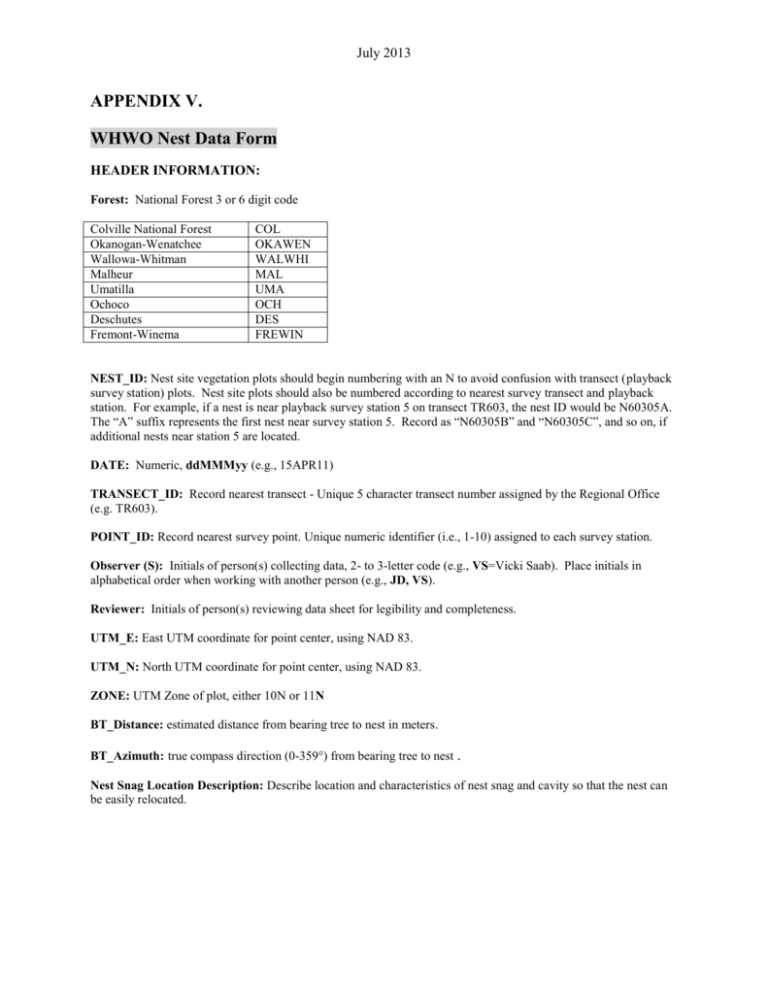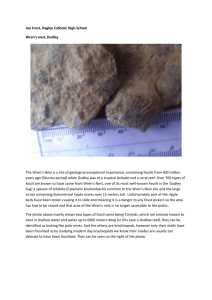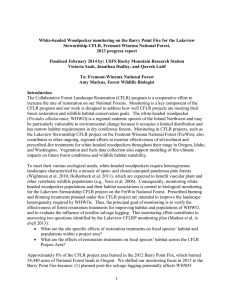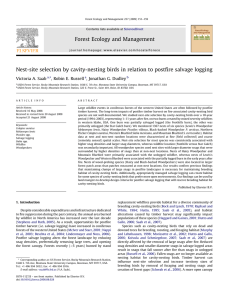Appendix V – Nest Data Form
advertisement

July 2013 APPENDIX V. WHWO Nest Data Form HEADER INFORMATION: Forest: National Forest 3 or 6 digit code Colville National Forest Okanogan-Wenatchee Wallowa-Whitman Malheur Umatilla Ochoco Deschutes Fremont-Winema COL OKAWEN WALWHI MAL UMA OCH DES FREWIN NEST_ID: Nest site vegetation plots should begin numbering with an N to avoid confusion with transect (playback survey station) plots. Nest site plots should also be numbered according to nearest survey transect and playback station. For example, if a nest is near playback survey station 5 on transect TR603, the nest ID would be N60305A. The “A” suffix represents the first nest near survey station 5. Record as “N60305B” and “N60305C”, and so on, if additional nests near station 5 are located. DATE: Numeric, ddMMMyy (e.g., 15APR11) TRANSECT_ID: Record nearest transect - Unique 5 character transect number assigned by the Regional Office (e.g. TR603). POINT_ID: Record nearest survey point. Unique numeric identifier (i.e., 1-10) assigned to each survey station. Observer (S): Initials of person(s) collecting data, 2- to 3-letter code (e.g., VS=Vicki Saab). Place initials in alphabetical order when working with another person (e.g., JD, VS). Reviewer: Initials of person(s) reviewing data sheet for legibility and completeness. UTM_E: East UTM coordinate for point center, using NAD 83. UTM_N: North UTM coordinate for point center, using NAD 83. ZONE: UTM Zone of plot, either 10N or 11N BT_Distance: estimated distance from bearing tree to nest in meters. BT_Azimuth: true compass direction (0-359°) from bearing tree to nest . Nest Snag Location Description: Describe location and characteristics of nest snag and cavity so that the nest can be easily relocated. July 2013 NEST SNAG CHARACTERISTICS Tree Species: four-letter tree code (e.g., PIPO = Pinus ponderosa) Decay Class: Determined during vegetation surveys. Enter the numeric value for the appropriate decay class of the snag (Bull et al. 1997): 1 = Snags that have recently died, typically have little decay, and retain their bark, branches, and top. 2 = Snags that show some evidence of decay and have lost some bark and branches, and often a portion of the top. 3 = Snags that have extensive decay, are missing the bark and most of the branches, and have a broken top. 4 = Burnt snag; almost entire outer shell is case-hardened by fire; looks like charcoal (not shown above). Snag DBH: Diameter at Breast Height (1.37 m) in centimeters, determined during vegetation surveys Nest Ht: Nest Height in meters Snag Ht: Snag/tree height in meters Cavity Orientation: true compass bearing (0-359°) of direction cavity faces Top Condition: (I=Intact, BB=Broken Before Fire, BA=Broken After Fire, F=Forked, DT=Dead Top) Aspect: True compass bearing (0-359°) of slope on which cavity tree resides, determined during vegetation surveys Degree Slope: Degrees slope to nearest tenth, determined during vegetation surveys Position on Slope: Position of cavity tree on slope (L=Lower, M=Middle, U=Upper) July 2013 VISITATION DATA Visit Date: Day and Month of visit (numeric) #Eggs: Enter # eggs in nest determined from actual count (i.e., you used a cavity viewer), circle value if certain count represents final number of eggs #Yng: Enter # nestlings determined from actual count (i.e., you used a cavity viewer), circle value if certain count represents final number of nestlings Beg-End Time: Beginning and ending time of observations in military time (e.g., 0742-0813) Observations: Detailed notes of observation. Stage: Stage of nest- (E =Excavation/Nest Building, L= Laying, I=Incubation, N= Nestling, F=Fledgling) Observer: Observer initials for each visit (e.g., VAS) Nest Fate: Circle single best fate code -- 1-Successful, 2-10 Failed due to: 2-bear; 3-corvid; 4-squirrel; 5-chipmunk; 6-snake; 7-weather; 8-cavity destroyed (i.e., cavity tree fell or broke below cavity entrance); 9-unknown; 10other (includes adult mortality, abandonment, ectoparasitism, predators not listed, human-caused failures). 11Fate unknown (cannot determine from data) Success/Failure Notes: Record detailed observations about why you think the nest was successful or failed Init Date: Initiation Date, Record date (ddmm) first egg was laid if known, or calculate by backdating Date Fated: Date (ddmm) on which nest fledged or failed, if known, otherwise enter median date between last two visits # Fledged: Number of nestlings that fledged from the nest Fledge Conf: Confidence that the number of fledglings reported is the final total (circle SURE or UNSURE)









